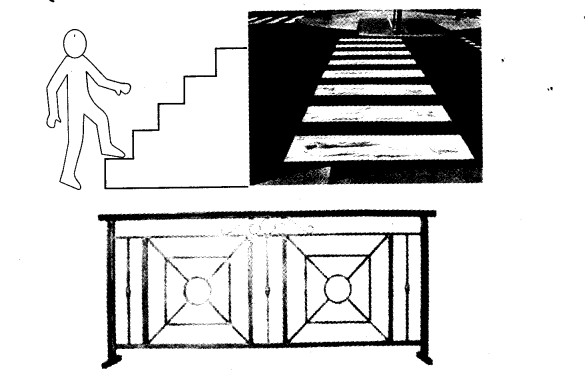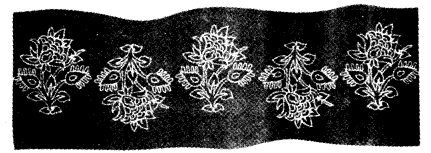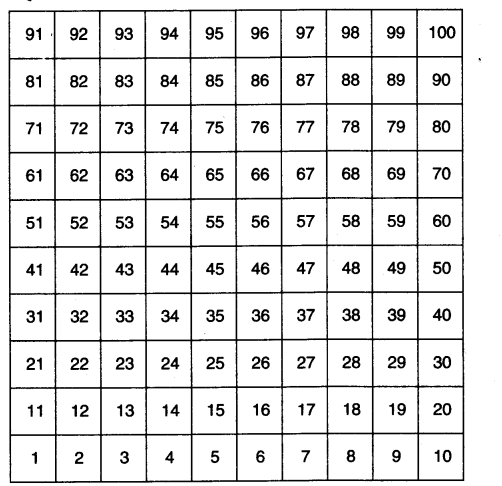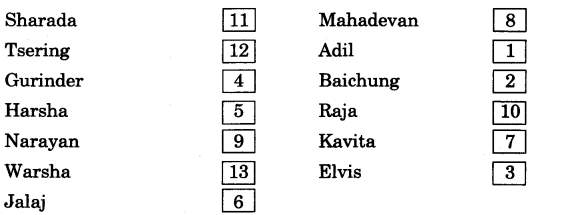Students can use Maths Mela Class 3 Solutions Chapter 10 Fun at Class Party Question Answer to explore alternative problem-solving methods.
Class 3 Maths Chapter 10 Fun at Class Party Question Answer Solutions
Fun at Class Party Class 3 Maths Question Answer
Class 3 Maths Chapter 10 Solutions
Children of Class 3 are preparing for a celebration in the class. Look at the picture.

Let us Do
Discuss and explain how you answer these questions based on the picture given above.
Question 1.
What are the various activities shown in the picture?
Answer:
The different activities shown in the picture are—Some children are decorating grey board. Two children are measuring table by hand span. A boy is measuring distance between the walls by footstep. A girl is measuring height of door with pencil.
Question 2.
How does Shelly find the height of the door?
Answer:
Shelly finds the height of the door with the help of pencil.
![]()
Question 3.
Leena and Adi use their hand spans to measure the length of the same table. Will they both get the same measurement?
Answer:
No, they will get the different measurement.
Question 4.
Circle the child with the longest ponytail.
Answer:

Question 5.
Tick (✓) paper strings in the classroom that are as long as the height of the window.
Answer:
Do yourself.
Question 6.
Find the distance between the two walls of the classroom. How did you find it? Can there be other ways of measuring it?
Answer:
The distance between the two walls of the classroom is 26 steps. We counted the footsteps. Yes, there can be other ways of measuring it.
Question 7.
Identify all the ways that children are using to measure length in this picture. Which way do you think is better and why?
Answer:
Children are using hand spans, foot spans and object like paper strings and pencil for measuring length.
I think paper string method is better because it could be use for measuring long and short lengths both and each child will get same measurements.
Children of Class 3 are decorating the board with paper strings of different colours.

Let us Do
Question 1.
In the picture above, colour the paper strings as instructed below.
(a) Colour the shortest paper string with red. Discuss how you identified the shortest string.
(b) Colour the longest paper string with green. Discuss how you identified the longest string.
Answer:
(a) Shortest Red
(b) Longest Green

Question 2.
How many more colourful paper strings will be needed to decorate the border of the green board?
Answer:
12 more colourful paper string will be needed to decorate the border of the green board.
Question 3.
How many of
![]() are needed to decorate the entire border of the board?
are needed to decorate the entire border of the board?
Answer:
30 are needed to decorate the entire border of the board.
Let us Do
Question 1.
Cut and paste a wool or cotton thread as long as the line given below.

Answer:
Do yourself (with the help of the Teachers/Parents).
Question 2.
Draw a string shorter than the string given below.

Answer:

Question 3.
Draw a string shorter than the decoration string Shelly and Adi are holding.

Answer:

![]()
Question 4.
Draw the other half of the moustache which is as long as the half of the moustache on the face shown in the picture.

Answer:

Question 5.
Look at the strings and help Adi choose the longest one. How did you find out? Discuss.

Answer:

Shelly and Adi need to take a large table inside the classroom for the party. The table is too heavy for both of them to move. Without lifting the table, how can they figure out if the table can go through the door of the classroom? Help them find out what they must do.

Can there be a way to take the table inside the door if both the length and the breadth are more than the width of the door?
Let us Play
Make a bridge using boxes or bags or any other objects available in your class. Place or arrange the boxes so that the bridge does not move. Take some objects from your class and guess if the objects can go through the bridge.

Can you name some things that cannot pass through your school gate? Discuss.
Are these true for all?
Children are measuring their body parts to make costumes for the drama.

They have made the following statements. Do you think they are true for all children? Let us check. Take help from your friends to measure. Tick (✓) the correct answer.
Question 1.
Your head is 3 handspans round. True/False
Answer:
False.
Question 2.
The length of your forearm is equal to the length of your feet. True/False
Answer:
False.
![]()
Question 3.
Your height is equal to the length of your arms wide open. True/False
Answer:
False.
Shelly wants to make curtains for the drama. Leena got her mother’s saree. Adi used his pencil to measure the length of the wall.


Steps for making a Metre long rope:
1. Take a metre rod or an inch tape and a rope or a thread.
2. Make a knot at one end of it.
3. Keep the metre

4. Mark one metre on the rope and make a knot there.
5. Now the length between the two knots is one metre. Check again whether the rope measures one metre.
Measure your height by marking one metre on the wall of your class.
Write the names of your friends whose heights are more than one metre and whose heights are less than one metre.

• Circle the tallest among these children:

Who is the tallest among them? Discuss.
Answer:

• Write the names of the objects around you, whose length is one metre, more than one metre, and less than one metre.

Answer:

Let us Do
Question 1.
Find the lengths of different objects by using one metre, half meter, and quarter metre ropes. Write their names and tick (✓) in the appropriate boxes.

Answer:

Question 2.
Mark a line on the floor as a Start line and then mark another line one metre from the Start line. Stand on the Start line and jump. Write the names of children who jump more than a quarter of a meter, half of a meter and a meter.
Answer:
Do yourself.
Question 3.
Take a ball or disc and try to throw it as far as you can. Now measure how far the throw was.
Answer:
Do yourself.
![]()
Let us Do
Question 1.
Measure the height of your teacher or parent using a metre long rope or a strip.
Answer:
Do yourself.
Question 2.
Estimate and cut one-metre long wool or thread. Ask your friends to do the same. Now verify with the help of the metre rope whose estimate is the closest.
Answer:
Do yourself.
Question 3.
Cut a one-metre long rope into 4 equal pieces. How many cuts did you make?
Answer:

Question 4.
How many footsteps fit into a metre rope?
Answer:
Do yourself.
Question 5.
Use a metre rope to find how long is a side of the class wall.
Answer:
Do yourself.
NCERT Solutions for Class 3 Mathematics Chapter 10 Play with Patterns (Old Syllabus)
Around Us
1.Look around you and list three things in which you find some patterns.
Ans.
Staircase, Zebra crossing, Railing in a balcony.
2.Draw some patterns which you have found around yourself.
Ans.

3.Can you see a pattern in the way each block is repeated?

Ans.
Yes, I can see that one block is placed upwards and the next is placed downwards.
Practice Time
Given below are some patterns.
1.Figure out the rule for each and continue the pattern.
Ans.
(a) In this pattern; the colour of the pot changes from red to blue and then to red at each step.
(b) In this pattern A is written twice, followed by B written once.
AABAABAAB
(c)In this pattern; the number of petals increases from 1 to 3 and to 5. After that this sequence is repeated.
(d)In this pattern the blue colour is moving apticlockwise in steps of one.
(e) In this pattern; the figure is rotating clockwise in steps of one.
(f) In this pattern; the sequence of morning, afternoon, evening and night is repeated.
Morning, Afternoon, Evening, Night, Morning, Afternoon, Evening, Night
Growing Patterns
1.Can you see the rule and continue the pattern?
Ans.
In this pattern; the number of marks in the oval is growing by one. After halfway mark the figure gets inverted.
Number Patterns
1.We have made some patterns with pictures. We can make patterns with numbers too. Like
21, 41, 61, 81, 101, 121
You know the next number, don’t you?
This series is growing by 20.
21, 41, 61, 81, 101,121, 141, 161, 181,
A.Look for the rules and continue these growing patterns:
(a)51, 56, 61, 66,————– ,———— ,————-
(b)7,————- ,21,28,35,————- ,————- ,————-
(c)2, 4, 8, 16, 32,————- ,————- , ————-
(d)12 A, 13 B, 14 C,————- ,————- ,————-
Ans.
(a) 51, 56, 61, 66, 71, 76, 81, 86
(6) 7, 14, 21, 28,35, 42, 49, 56
(c) 2, 4, 8,16, 32, 64, 128, 256
(d) 12 A, 13 B, 14 C, 15 D, 16 E, 17 F.
B. Look at these growing patterns. Find out what to add to each number to get the next one.
(a)1, 3, 6, 10,———- ,————- ,————–
(b)0, 2, 6, 12,———- ,———–,————–
(c)1, 3, 7, 13,————–,———–, ————-
(d)2, 3, 6, 11,18,———— ,———–,————-
Ans.
(a) Following sequence is observed in this pattern:
1 + 2 = 3 3 + 3 = 6 6 + 4=10
The number which is added in each step is growing by 1 Hence the pattern is as follows:
1, 3, 6,10, 15, 21, 28, 36, 45
(b)Following sequence is observed in this pattern:
0 + 2 = 2 2 + 4 = 6 6 + 6 = 12
The number which is added in each step is growing by 2.
Hence the pattern is as follows:
0, 2, 6, 12, 20, 30, 42, 56, 72
(c)Following sequence is observed in this pattern:
1 + 2 = 3
3+4=7
7 + 6 = 13
The number which is added in each step is growing by 2 Hence the pattern is as follows:
1, 3, 7, 13, 21, 31, 43, 57, 73 ’
(d) Following sequence is observed in this pattern:
2 + 1 = 3
3 + 3 = 6 6 + 5 = 11 11 + 7 = 18
The number which is added in each step is growing by 2 Hence the pattern is as follows:
2, 3, 6, 11, 18, 27, 38, 51, 66
Secret Messages
Amrita and Paritosh are writing secret messages:
3W3H3E3R3E 3A3R3E 3Y303U
3 I3 N 3T3H3E 3C3A3N3T3E3E3N
1.Can you tell what they are trying to say?
Ans.
Following are the secret messages:Where are you?
In the canteen
3.There are two secret messages. Look at the patterns and find the hidden sentences.
1I2L204V5E6Y708U
Ans.
The message is:I LOVE YOU
4.ATBHCIDSEBFOGOHKIIJSKFLUMN
Ans.
The message is:
THIS BOOK IS FUN
5.Now you also make your own secret messages.
Ans.
1 I 2 L 3 O 4 V 5 E 6 I 7 N8D9I10A I LOVE INDIA
AMBACNDMEOFHGAHNILJIKVLEMSNAOTPDQERLS
HTI
MANMOHAN LIVES AT DELHI
Even and Odd Number Patterns

Half these numbers are in yellow. What patterns do you see in these numbers? Continue the same pattern and fill in the blanks:
96, 98,100,102,104,106, IQS, 110,112,114
1.How far can you continue this pattern?
Ans.
This pattern can be continued endlessly.
These numbers have a special name. They are called even numbers.
2.Do any of these even numbers end with 3 or 5?
Ans.
None of the even numbers end with 3 or 5.
3.What do even numbers end with?
Ans.
Even numbers end with 2, 4, 6, 8 or 10.
4.Look at the pattern of numbers in blue. Continue the pattern and fill in the blanks.
Ans.
99,101,103,105,107,100, 111, 113,115
5.What do the numbers in blue end with?
Ans.
The numbers in blue end with 1, 3, 5, 7 or 9.
6.Write all odd numbers between 400 and 410.
Ans.
401, 403, 405, 407, 409.
7.Write all even numbers between 155 and 165.
Ans.
156,158,160,162,164.
8.If we add 1 to any odd number we get an————(even/odd) number.
Ans.
If we add 1 to any odd number we get an even number.
9.If we add’l to any even number we get an————(even/odd) number.
Ans.
If we add 1 to any even number we get an odd number.
10.What do you get if you add an even number to an odd number?
Ans.
Odd number.
Names in an Order
Adil has to arrange this list so that the names starting with A comes first and then come those with B, C, D and so on. Number these names in the order in which they will come.

Jalaj is proud to have a special name. He says if you read it backwards it is still the same.
1.Which of the following names have the same pattern?
Harsh, Anna, Kanak, Munna, Ongbi
Ans.
Anna and Kanak.